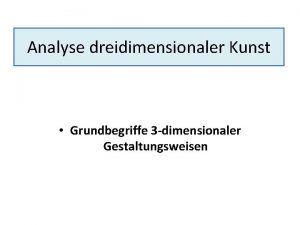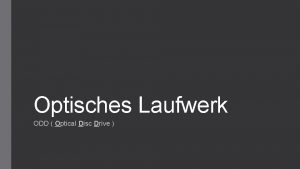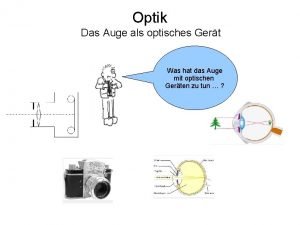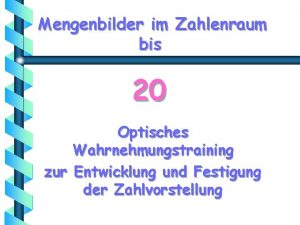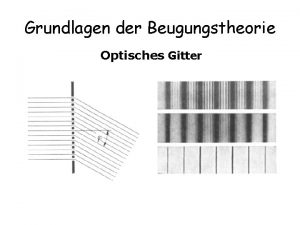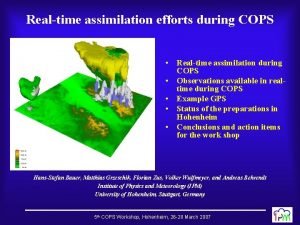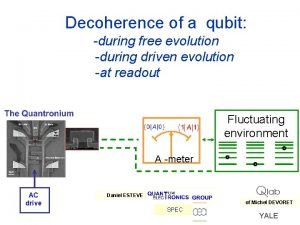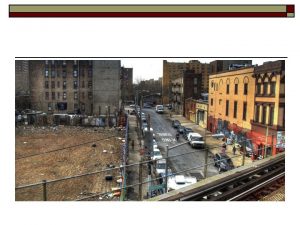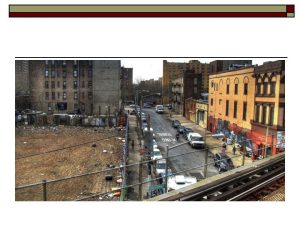Materialsammlung Optisches Spielzeug Introduction During the 19 th






































- Slides: 38

Materialsammlung Optisches Spielzeug

Introduction During the 19 th century a number of inventions were made that were based on the Phi phenomenon or the persistence of vision. It starts with John Paris who uses his thaumatrope (1824) to demonstrate this phenomenon to the Royal College of Physicians. The Phi phenomenon entails that the brain retains the image of the eyes a bit longer to ensure that the world does not go black every time you blink your eyes. All of the following optical toys have in common that each image is viewed for an instant (16 frames per second) and the view is interrupted by a neutral stage, otherwise the eye would only see a blur. The optical toys get names derived from the Greek that end on 'trope' for turning or 'scope' for viewing. Weitere Quellen: "Philosophical Toy World" requires the Shockwave plug in and the Quick. Time 4. 0 plug in but it's fun. "Discs and drums or how the images learned to walk" in de Luikerwaal. "Persistence of vision" by Brian Carusella with a description of several optical instruments and how to build your own. The collection of pre-20 th century optical toys and illusionary devices donated to NCSSM by Dr. Ralph Wileman. More on the subject in "Magic Machines" in the Adventures in Cyber. Sound by Russell Naughton. "Views at home: 19 th century optical entertainments" of the The Bill Douglas Center for the History of Cinema and Popular Culture. An introduction to early cinema by J. S. Walters. As these toys added to the knowledge needed for the invention of cinema you can read about their inventors in: The Complete History of the Discovery of Cinematography by Paul T. Burns. "Optisches Spielzeug oder wie die Bilder laufen lernten" (book) by Georg Füsslin.

Thaumatrope 1824 John Ayrton Paris The Thaumatrope is invented by John Ayrton Paris in 1824 to demonstrate the persistence of vision. It consists of one disc with a different image on both sides and a string on either side of the disc. The object is to turn the disc to get torsion in the string and then pull the string. Even if the disc turns the image is still seen and assembles with the other image. Technische Anmerkungen: Quelle: http: //web. inter. nl. net/users/anima/optical/thauma/

Thaumatrop (Wunderscheibe) 1 Buchhinweis: Optisches Spielzeug oder wie die Bilder laufen lernten Technische Anmerkungen: Quelle: http: //www. rfl. de/fuesslin/os. htm 18

1830 Michael Faraday On 10 December 1830, Michael Faraday(1791 -1867) gives a lecture at the Royal Institution. The publication appears in February 1831: "On a peculiar Class of Optical Illusions". Continuing on what Peter Mark Roget (1779 - 1869) had published in the Philosophical Transactions, he describes two parallel discs, revolving on the same axis, in opposite directions, each having 16 cogs. When viewed in a mirror a stationary image is seen. He does not refer to Plateau's work, done before 1831 and which had been published in the Correspondance mathémathique et physique. Later Faraday writes that the honour is due to Plateau. Technische Anmerkungen: Quelle: http: //allserv. rug. ac. be/~ivhaeghe/mhsgent/englplat 5. html

Phenakistiscope 1832 J. Plateau, Corresp. Math. Phys. 1832 VII p. 291 In "Sur un nouveau genre d'illusions d'optique", Plateau describes the construction and the action of a disc with 16 slits and 16 intermediate sectors. When 16 identical drawings are put in the sectors, one sees a stationary image, when looking through the slits at the revolving disc in a mirror. This is in fact the experiment of Faraday. The brilliant contribution of Plateau comes when in stead of putting 16 identical images in the sectors he draws 16 images, which change little by little. Because of the visual persistence the images seen in swift succession will fade into each other and a suggestion of movement is created. It is for this reason that Joseph Plateau is cited as the precursor of the movie, more accurately he is the precursor of the animation film. Photo MD, Museum for the History of Sciences, Ghent : Quelle: http: //allserv. rug. ac. be/~ivhaeghe/mhsgent/englplat 5. html

Phenakistiscope ('spindle viewer') 1832 J. Plateau It is remarkable that in the original paper the discs and the experiment itself are described, but they receive no name. It is only in a later paper in 1831 "Des illusions optiques sur lesquelles se fonde le petit appareil appelé récemment Phénakisticope" that a name is introduced. It is not clear who introduced the name "phénakisticope". The title of the paper suggests that it was not Joseph Plateau himself. Ackerman in London sells the discs in 1833 under the name "Fantascope", Alphonse Giroux in Paris introduces them first as "phénakisticope", later as "phénakistiscope". Plateau himself also uses the term "phénakisticope". To day the spelling "phenakistiscope" is preferred. Detail of the original hand-coloured disc compared to a printed version. The figure which is completely red is a hand-coloured draft for a disc. The red-and-blue figure is the printed version by Ackermann (London). Only the first discs printed by Ackermann bear the mention "by prof. Plateau". Collection J. Plateau, Ghent Museum for the History of Sciences, Ghent : Quelle: http: //allserv. rug. ac. be/~ivhaeghe/mhsgent/englplat 5. html

Joseph Plateau (1801 - 1883) Joseph Antoine Ferdinand Plateau is born in Brussels on the 14 th of October 1801. On 12 march 1829 the doctoral thesis of Joseph Plateau is submitted to Quetelet for advice. Although it contains only 27 pages, it formulates a great number of fundamental conclusions. It contains the first results of the research into the effect of colours on the retina (duration, intensity and colour), the mathematical research into the intersections of revolving curves (locus), the observation of the distortion of moving images, and the reconstruction of distorted images (anorthoscopic discs). The thesis "Dissertation sur quelques propriŽtŽs des impressions produites par la lumi� re sur l'organe de la vue" is presented at the university on 9 June 1829. At the University of Li� ge, the doctoral thesis of Joseph Plateau is the very first in physical and mathematical sciences to be written in French and not in Latin. Plateau dies on 15 September 1883. Visual persistence before Plateau's time Aristotle (394 b. C - 322 b. C) is the first to describe how he sees a persistent image after looking into the sun, image that only slowly fades away. Leonardo da Vinci (1452 - 1519) also tackles the problem: an object that moves quickly colours its path with its own colour. Joseph Plateau Daguerreotype Pelizarro, Ghent, 1843. © Museum for the History of Sciences, Ghent. Digital restoration MD. Johannes Segner (1704 - 1777) observes (and he was not the first to do so) that one sees a red full circle when one moves a red-hot coal around in the dark, and does this at high enough speed. The revolving time offers a measure for the duration of the "impression". Segner estimates this to be 0. 1 s. The Chevalier Patrice d'Arcy (1725 - 1779) attaches a red-hot coal to a cross that is driven by a descending weight and turns around at a controlled speed. He estimates the persistence of the visual impression to be 1/7 th or 0. 15 s. This value is dismissed by Plateau.

Arcs of a circle used by J. Plateau to study the persistence of an image. J. Plateau, Collection J. Plateau, Ghent The arcs are mounted on a black circular background. This is then revolved at increasing speeds. Starting from a certain angular velocity one observes a complete circle. For his systematic study of the "persistence of lightimpressions" (persistance des impressions lumineuses) and the observation and explanation of "accidental colours" (couleurs accidentelles). Plateau uses coloured arcs of circles, mounted on a black disc. From the experiments with these revolving discs, Plateau concludes: 1. a visual impression needs a certain time to form and to disappear 2. impressions fade away slowly, and don't disappear suddenly 3. after the observation of a colour has taken place, it takes on average 0, 34 sec to completely disappear. 4. in the sequence white, yellow, red, blue the colours produce the most intense and durable impression Besides the duration of the impression, thesis also describes research about the observation of socalled "accidental colours" (i. e. complementary colours) and their relationships. Plateau explains his observations as "persistence of the lightimpressions". He links the persistence directly to the retina, a generally accepted view in the 19 th century. In 1912 Max Wertheim (1880 - 1943) definitively establishes that the persistence of the image is linked to the brain (due to a perceptual construction the observer sees two successive stimuli received by the retina as a movement). Joseph Plateau (1801 - 1883) Portrait in complementary colours J. Plateau, Collection J. Plateau, Ghent This portrait very probably represents Quetelet The original complementary colours have faded in the course of time, and thus the digital transposition into a positive gives a not too accurate image. This shows a modern digital correction.

Joseph Plateau (1801 - 1883) Belgian physicist, born in Brussels 14 October 1801; died at Ghent, 15 September 1883. His father, a flower-painter, wanted him to be an artist, and , after his elementary studies, he was sent to the Academie de Dessein at Brussels. Left an orphan at fourteen, Joseph Plateau became the ward of a maternal uncle, an advocate, who intended him to study law. His intermediate studies were made at the Athénée Royal at Brussels, and in 1822 he entered the University at Liège, being enrolled as a student both of philosophy and letters and of science. He graduated as a doctor of physical and mathematical sciences, 3 June 1829. After a brief period of teaching in the Athenee Royal at Liège, he was appointed, in 1835, professor of experimental physics in the University of Ghent. His thesis for the doctorate had been "On certain properties of the impressions produced by light upon the organ of sight". This line of research he followed for many years, studying successively the persistence of luminous impressions on the retina, accidental colours, irradiation, the contrast of colours, coloured shadows, etc. Many of the results obtained by him are still classical. In the course of these researches he once kept his naked eye fixed on the sun for twenty-five seconds, and this imprudence brought on a choroid inflammation which, in 1843, resulted in total blindness. A thesis with which people disagree, saying that his blindness was caused by an eye-infection. There are people who did the same experience and were not blinded. More important, in his view, than the projection of images on the retina was the function of the blind spot, which transforms images into nerve impulses that are then communicated to the brain. It is not so much through the eyepiece of a camera that a human being observes the world, but through the constant compositing of images. In actual fact, it all boils down to a combination of our two points of vision into a single , logical comprehensive vision of the outside world. Being obliged to give up teaching, he nevertheless continued his experimental work with admirable courage and marvellous success, helped by his elder son, Félix Plateau, the naturalist, his son-in-law, Van der Mensbruyghe, the physicist (1835 -1911), and some friends and colleagues in the University of Ghent. To this period belongs almost all his famous research on the statics of liquids freed from pressure, on surface tension, and on the properties of thin liquid plates. After 1844 Joseph Plateau had no laboratory but studied in his own modest home. He himself planned all the experiments and arranged all the details in advance. His assistants would announce in a loud voice everything they were doing, all that they observed, and the results of each process. Joseph Plateau would then dictate the notes and, later on, the text of the memoirs for publication. In this way he worked until he was more than eighty. Quelle: http: //club. euronet. be/vanpevenaege/Joseph_Plateau. html

Anorthoscopes 1830 -36 Plateau From 1830 onward, Plateau studies the combination of two moving curves to one stationary image In his doctoral thesis he describes this as "une espèce toute nouvelle d'anamorphoses". In 1836 he uses the name "anorthoscope" for the first time in the "Notice sur l'anorthoscope" in which Plateau presents his new instrument to the members of the Academy. The instrument (in brass) contains two wheels, different in diameter, on one axis, and driven by gears. The wheels are interchangeable, so that it is possible to have different relative speeds. Between 1830 and 1836 several short papers are published in relation to visual perception. In 1849 all this results in three very elaborate review papers "Deuxième (troisième en quatrième) note sur de nouvelles applications curieuses de la persistance des impressions de la rétine" in which Plateau goes further into the matter of the angular velocities of the revolving anorthoscopic discs and the discs with slits. Quelle: http: //allserv. rug. ac. be/~ivhaeghe/mhsgent/englplat 4. html

Phenakistiscope ('spindle viewer') Stroboscope ('apparition-box-viewer') 1832 Joseph Plateau Simon Ritter von Stampfer Invented by Joseph Plateau (Ghent, Belgium) and independently also by Professor Simon Ritter von Stampfer of the Polytechnical Institute (Vienna, Austria) in 1832. Plateau calls his invention the Phenakistiscope ('spindle viewer') and Von Stampfer calls his the Stroboscope ('apparition-boxviewer'). PHENAKS: Deceiver SKOPEO: I look But it is also known under names as: Fantascope, Phantamascope, Magic Disc or Kaleidorama. The Phenakistiscope disc is mounted on a spindle and viewed through the slots with the images facing the mirror. With the Stroboscope (above, right) it is possible to view the movement through the slots while two disks are moving simultaneously without using a mirror. Technische Anmerkungen: Quelle: http: //web. inter. nl. net/users/anima/optical/phena/

Phenakistiscope ('spindle viewer') Stroboscope ('apparition-box-viewer') Joseph Plateau Simon Ritter von Stampfer The Phenakistiscope (or phenakisticope/ phenakistoscope) meaning: 'deceptive view', was invented simultaneously in 1830 by physicist Joseph Plateau in Belgium, and scientist Simon Stampfer in Austria. A cardboard disc with slots around the edge, and drawings between the slots, was spun on an axle in front of a mirror. Sequence drawings were arranged on one side of the disc, and the viewer looked through the slots at the reflections of the pictures in the mirror. The eye saw each picture only briefly as it moved opposite to the slot, and the view was then obscured by the disc until the next image was seen though the next slot, and so on. The sequence of images was designed to be cyclic. Subjects ranged from dancing jesters, cellists, and circus performers to abstract patterns. The last phase of the movement joined up with the first phase, so the motion was repeated continually. Later versions had separate shutter disc and picture disc on the same spindle. The viewer looked through the slots in the revolving shutter at the sequence pictures: no mirror was necessary. The toy was marketed in England in 1831, and quickly became popular under a variety of names in many countries. Quelle: 1832

Phenakistiscope ('spindle viewer') Stroboscope ('apparition-box-viewer') 1832 Joseph Plateau Simon Ritter von Stampfer Technische Anmerkungen: With special thanks to Brian Carusella for the image of this phenakistiscope disk. Quelle: http: //web. inter. nl. net/users/anima/optical/phena/

Phenakistiscope ('spindle viewer') Stroboscope ('apparition-box-viewer') 1832 Joseph Plateau Simon Ritter von Stampfer Model: Fantascope (Ø 23. 9 cm) Artist: Thomas Talbot Bury Made and distributed by: Rudolf Ackermann, 96 Strand, London (1833) Model: Fantascope (Ø 25. 7 cm) Artist: Thomas M. Baynes Made by: Rudolf Ackermann, 96 Strand, London (1833) Distributer: Gillard, 48 Strand, London Quelle: http: //web. inter. nl. net/users/anima/optical/phena/

Phenakistiscope ('spindle viewer') Stroboscope ('apparition-box-viewer') 1832 Joseph Plateau Simon Ritter von Stampfer Model: Fantascope (Ø 24. 4 cm) Made and distributed by: Rudolf Ackermann, 96 Strand, London (1833) Model: Fantascope (Ø 24 cm) Artist: Thomas T. Bury Made and distributed by: Rudolf Ackermann, 96 Strand, London (1833) Quelle: http: //web. inter. nl. net/users/anima/optical/phena/

Phenakistiscope ('spindle viewer') Stroboscope ('apparition-box-viewer') 1832 Joseph Plateau Simon Ritter von Stampfer Model: Fantascope (Ø 24. 6 cm) Artist: Thomas M. Baynes Made by: Rudolf Ackermann, 96 Strand, London (1833) Distributer: Gillard, 48 Strand, London Quelle: http: //web. inter. nl. net/users/anima/optical/phena/

Phenakistiscope ('spindle viewer') Stroboscope ('apparition-box-viewer') 1832 Joseph Plateau Simon Ritter von Stampfer Model: Fantascope (Ø 24. 7 cm) Artist: Thomas M. Baynes Made by: Rudolf Ackermann, 96 Strand, London (1833) Distributer: Gillard, 48 Strand, London The image of the disc is published by Plateau on January 20, 1833 in his article "Sur un nouveau genre d'illusion d'optique, " Correspondance mathématique et physique, Brussel, Nº 6, 1833, p. 365 -368. Quelle: http: //web. inter. nl. net/users/anima/optical/phena/

Phenakistiscope ('spindle viewer') Stroboscope ('apparition-box-viewer') 1832 Joseph Plateau Simon Ritter von Stampfer Model: Fantascope (Ø 24. 7 cm) Artist: T. M. Baynes Publisher: Rudolf Ackermann, 96 Strand, London (1833) Distributer: Gillard, 48 Strand, London Model: Stroboscope (Ø 27. 7 cm) Made by: James Black, Woolwich (c. 1834) Distributer: Charles Tilt, Fleet Street London "The stroboscope Nº 11 by professor Stampfer. Published by Black, Woolwich and sold by Charles Tilt, Fleet St. , London" Quelle: http: //web. inter. nl. net/users/anima/optical/phena/

Phenakistiscope ('spindle viewer') Stroboscope ('apparition-box-viewer') 1832 Joseph Plateau Simon Ritter von Stampfer This zoopraxographical fan with "A couple waltzing" was sold in Chicago in 1893. A handle was attached through a hole in the center and the cardboard circle could be waved like a fan. TModel: Fantascope (Ø 24. 5 cm) Artist: J. P. Made and distributed by: Rudolf Ackermann, 96 Strand, London (1833) Quelle: http: //web. inter. nl. net/users/anima/optical/phena/

Phenakistiscope ('spindle viewer') Stroboscope ('apparition-box-viewer') 1832 Joseph Plateau Simon Ritter von Stampfer The wheels were usually mounted on a rod by a nail or screw through the hole in the centre of the wheel. One had to face the side with the picture on it to an ordinary mirror, holding the rod in one hand. Then, by looking at the reflection of the pictures through the slots round the edge of the wheel and by spinning the wheel with the other hand, the pictures leaped into action. Quelle: http: //www. luikerwaal. com/newframe_uk. htm? /precinema _uk. htm

Phenakistoscope 1840 A Phenakistoscope Animation, c. 1840 Laughing man http: //www. opticaltoys. com/ Technische Anmerkungen: Quelle: http: //www. acmi. net. au/AIC/phenakistoscope_ani. html entnommen aus Jack and Beverley's Optical Toys

Zoetrope 1834 William Horner The Zoetrope is invented by William Horner (1786 -1837) and patented in 1834. Only decades later it is marketed in France (1860) and England the U. S (1867 patent and image of the Milton Bradley Co. zoetrope at the George Eastman House) The zoetrope is based on the same principle as the phenakistiscope, but is cylindrical in shape. This enabled several people at the same time to view the moving pictures - an advance over the single spectator of the earlier toy. The English mathematician W. G. Horner was the first to describe the zoetrope, calling it the 'daedaleum‘ Quelle: http: //web. inter. nl. net/users/anima/optical/index. htm

Zoetrope 18 1 In 1867 an American, William Lincoln, patented 'The Zoetrope' - the first use of the word. It was manufactured in large quantities. Most 19 th century zoetropes had thirteen slots. A strip with 12 images will produce a moving subject that appears to progress forwards. A strip of 13 images (the same number as slots) gives a moving image that is stationary. As the figures are always moving when viewed, they appear rather fuzzy. . Milton Bradley was granted a British patent in 1867. A popular model was produced in Britain by the London Stereoscopic Company. In addition to strips, some zoetropes had paper discs that fitted into the base, usually giving moving geometric figures. In many shapes and forms the zoetrope has survived as a toy to this day. Quelle: http: //easywe. easynet. co. uk/~s-herbert/zoe. htm

Zoetrope Three Blind Mice (E. ) by the London Stereoscopic Company - 1870 18 Roley Poley by the London Stereoscopic Company With special thanks to Giorgio Davi for the image. Quelle: http: //web. inter. nl. net/users/anima/optical/zoetrope/index. htm

Zoetrope The Black Turnover With special thanks to Giorgio Davi for the image. 18 Foot Ball With special thanks to Giorgio Davi for the image. Quelle: http: //web. inter. nl. net/users/anima/optical/zoetrope/index. htm

Zoetrope Frog Foot Ball With special thanks to Giorgio Davi for the image. Quelle: http: //www. luikerwaal. com/precinema_uk. htm 18

Praxinoscope 1878 Emile Reynaud The problem with the Zoetrope is that the small slots do not let enough light through. It is Emile Reynaud (1878) who makes an adaptation on the Zoetrope with mirrors instead of slots. The Praxinoscope Theater has also surrounding images to make the experience more complete. Technische Anmerkungen: These 2 animations are adaptations of the 9 Praxinoscope strips that Van Cort used to offer with their Praxinoscope reproduction. Quelle: http: //web. inter. nl. net/users/anima/optical/index. htm

Praxinoskop 18 1 Praxinoskop-Theater - optisches Spielzeug zur Betrachtung gezeichneter Bewegungsszenen über einen polygonalen Spiegel. Bei Sicht durch die Deckelöffnung scheint das Motiv von einem ebenfalls gespiegelten Dekor umrahmt Animation einer Hundedressur - Bildstreifen, gezeichnet in 12 Phasen, zur Betrachtung im Praxinoskop Quelle: http: //www. dtmb. de/Rundgang/Filmtechnik/txt/body 2. html

Praxinoscope Theatre - Zoetrope 1879 /70 1 First, a whimsical toy, the 1879 Reynaud "Praxinoscope Theatre" demonstrates how persistence of vision allows human eyes to see rapid still picture sequences as motion. Second, another motion picture toy which predates movies is the Zoetrope, this one a Milton Bradley product available ca. 1870. Technische Anmerkungen: Quelle: http: //www. eastman. org/10_colmp/10_video/10_vid_toy. h tml

18 1 Technische Anmerkungen: Quelle:

18 1 Technische Anmerkungen: Quelle:

18 1 Technische Anmerkungen: Quelle:

18 1 Technische Anmerkungen: Quelle:

18 1 Technische Anmerkungen: Quelle:

18 1 Technische Anmerkungen: Quelle:

18 1 Technische Anmerkungen: Quelle:

18 1 Technische Anmerkungen: Quelle:
 Raumvolumen kunst
Raumvolumen kunst Hình ảnh bộ gõ cơ thể búng tay
Hình ảnh bộ gõ cơ thể búng tay Bổ thể
Bổ thể Tỉ lệ cơ thể trẻ em
Tỉ lệ cơ thể trẻ em Chó sói
Chó sói Tư thế worm breton
Tư thế worm breton Hát lên người ơi alleluia
Hát lên người ơi alleluia Các môn thể thao bắt đầu bằng tiếng chạy
Các môn thể thao bắt đầu bằng tiếng chạy Thế nào là hệ số cao nhất
Thế nào là hệ số cao nhất Các châu lục và đại dương trên thế giới
Các châu lục và đại dương trên thế giới Công thức tính độ biến thiên đông lượng
Công thức tính độ biến thiên đông lượng Trời xanh đây là của chúng ta thể thơ
Trời xanh đây là của chúng ta thể thơ Mật thư tọa độ 5x5
Mật thư tọa độ 5x5 Phép trừ bù
Phép trừ bù Phản ứng thế ankan
Phản ứng thế ankan Các châu lục và đại dương trên thế giới
Các châu lục và đại dương trên thế giới Thể thơ truyền thống
Thể thơ truyền thống Quá trình desamine hóa có thể tạo ra
Quá trình desamine hóa có thể tạo ra Một số thể thơ truyền thống
Một số thể thơ truyền thống Cái miệng nó xinh thế
Cái miệng nó xinh thế Vẽ hình chiếu vuông góc của vật thể sau
Vẽ hình chiếu vuông góc của vật thể sau Nguyên nhân của sự mỏi cơ sinh 8
Nguyên nhân của sự mỏi cơ sinh 8 đặc điểm cơ thể của người tối cổ
đặc điểm cơ thể của người tối cổ Ví dụ về giọng cùng tên
Ví dụ về giọng cùng tên Vẽ hình chiếu đứng bằng cạnh của vật thể
Vẽ hình chiếu đứng bằng cạnh của vật thể Phối cảnh
Phối cảnh Thẻ vin
Thẻ vin đại từ thay thế
đại từ thay thế điện thế nghỉ
điện thế nghỉ Tư thế ngồi viết
Tư thế ngồi viết Diễn thế sinh thái là
Diễn thế sinh thái là Các loại đột biến cấu trúc nhiễm sắc thể
Các loại đột biến cấu trúc nhiễm sắc thể Các số nguyên tố
Các số nguyên tố Tư thế ngồi viết
Tư thế ngồi viết Lời thề hippocrates
Lời thề hippocrates Thiếu nhi thế giới liên hoan
Thiếu nhi thế giới liên hoan ưu thế lai là gì
ưu thế lai là gì Hổ đẻ mỗi lứa mấy con
Hổ đẻ mỗi lứa mấy con
